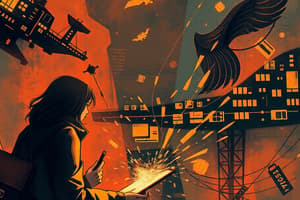Podcast
Questions and Answers
What are the three components of semiotic analysis highlighted in the text?
What are the three components of semiotic analysis highlighted in the text?
- Evaluation, interpretation, and representation
- Material traits, concepts, and values
- Basic semiotic plane, iconic plane, and contexts (correct)
- Ancient Filipinos, Ifugao tribe, and eight wonder of the world
Where is meaning rooted according to the text?
Where is meaning rooted according to the text?
- In the values of the Ifugao tribe
- In the material traits of the picture symbol
- In the content structure at all times (correct)
- In the concepts of the picture symbol
What does the art piece created by the ancient Filipinos represent?
What does the art piece created by the ancient Filipinos represent?
- Culture of the Ifugao tribe (correct)
- Technology advancements in the 21st century
- Religious symbols of ancient Rome
- A modern cityscape
Why is the enormous step of rice fields created by the Ifugao tribe considered valuable?
Why is the enormous step of rice fields created by the Ifugao tribe considered valuable?
What does the text imply about the younger generation of the Ifugao tribe?
What does the text imply about the younger generation of the Ifugao tribe?
Which aspect is fundamental to generating meaning in semiotic analysis?
Which aspect is fundamental to generating meaning in semiotic analysis?
What are the two main elements that derive the meaning of visual arts?
What are the two main elements that derive the meaning of visual arts?
What does the text state that semiotics is concerned with?
What does the text state that semiotics is concerned with?
What are the two main aspects of the semiotic plane according to the text?
What are the two main aspects of the semiotic plane according to the text?
Which of the following is NOT mentioned in the text as a common example of semiotics?
Which of the following is NOT mentioned in the text as a common example of semiotics?
How does the text describe the scenery and fashion of the people in the movie?
How does the text describe the scenery and fashion of the people in the movie?
What does the text say about the story of Romeo and Juliet?
What does the text say about the story of Romeo and Juliet?
What does the text say was the original basis for the movie?
What does the text say was the original basis for the movie?
What is meant by the 'iconic plane' in semiotic analysis?
What is meant by the 'iconic plane' in semiotic analysis?
What is the main difference between the 'basic semiotic plane' and the 'iconic plane' according to the text?
What is the main difference between the 'basic semiotic plane' and the 'iconic plane' according to the text?
What does the text say the movie gives the audience a choice of feeling?
What does the text say the movie gives the audience a choice of feeling?
What is the primary focus of the 'iconic plane' in semiotic analysis according to the text?
What is the primary focus of the 'iconic plane' in semiotic analysis according to the text?
What is the key relationship that cannot be separated in both the basic semiotic plane and the iconic plane according to the text?
What is the key relationship that cannot be separated in both the basic semiotic plane and the iconic plane according to the text?
Study Notes
Semiotic Analysis
- Semiotic analysis involves the study of signs and how meaning is generated through the connections between material traits and concepts/values.
- The semiotic analysis includes three planes: basic semiotic, iconic, and contexts.
Basic Semiotic Plane
- The basic semiotic plane deals with the material aspect of the work.
- It consists of the signifier (material/physical aspect) and the signified (non-material aspect as concept and value).
- Examples of semiotics include traffic signs, emojis, and logos.
Iconic Plane
- The iconic plane deals with the features of the image itself.
- It includes the choice of the subject, which may bear social and political implications.
- The positioning of the figure (frontal, in profile, three-fourths, etc.) implies its bearing to the meaning of the work.
Contexts
- Contexts refer to the socio-cultural conventions of a particular society and period.
- The meaning of the visual arts is derived from human psychophysical experiences and socio-cultural conventions.
Examples of Semiotic Analysis
- The rice fields of the Ifugao tribe represent a culture of unity and devotion, and its beauty is a testament to the ancestors' management.
- The movie "Malaga" is a love story based on Romeo and Juliet, with settings and costumes that evoke a sense of art and evoke a weary and disappointing feeling in the audience.
- The iconic plane analysis of the movie shows that the choice of subject and positioning of the figure implies social and political implications, and the scenery and fashion of the people in the movie provides a glimpse of the past.
Studying That Suits You
Use AI to generate personalized quizzes and flashcards to suit your learning preferences.
Description
Explore the theoretical aspect of semiotic analysis in art, focusing on the basic semiotic plane, iconic plane, and contexts. Learn how meaning is generated through the connections between material traits and concepts/values in specific art pieces.




